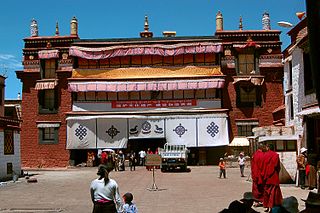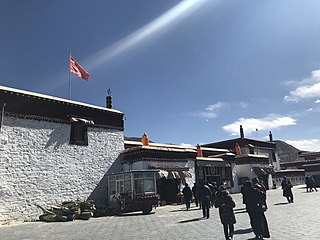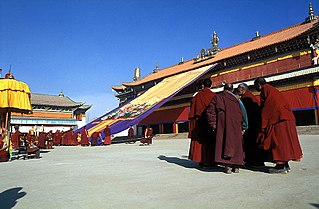
Lhasa, officially the Chengguan District of Lhasa City, is the inner urban district of Lhasa City, Tibet Autonomous Region, Southwestern China.

Bhrikuti Devi (Sanskrit: भृकुटी, known to Tibetans as Bal-mo-bza' Khri-btsun, Bhelsa Tritsun, or simply, Khri bTsun was a princess of the Licchavi kingdom in Nepal. In c.622 Bhrikuti became the first wife and queen of the king of Tibet, Songtsen Gampo. Bhrikuti was seen as an incarnation of Green Tara, and is credited for bringing Buddhism to Tibet, together with the Jowo Mikyo Dorje statue for which the Jokhang Temple in Lhasa was built.

The Jokhang, or the Ra sa 'phrul snang gtsug lag khang, or Qoikang Monastery, or Zuglagkang,, is considered the "heart of Lhasa". The Jokhang consists of a Tibetan Buddhist temple, its temple complex, and a Gelug school monastery. Located in Barkhor Square, it was built in c.640 by King Songsten Gampo to house the Jowo Mikyo Dorje, a statue of Akshobhya Buddha, brought to Tibet by his Nepalese queen, Bhrikuti. Another statue, the Jowo Shakyamuni, brought by his Tang Chinese queen Wencheng, is currently housed in the temple and the Jowo Mikyo Dorje is housed in the Ramoche, in Lhasa.

Songtsen Gampo, also Songzan Ganbu, was the 33rd Tibetan king of the Yarlung dynasty and he established the Tibetan Empire. As the first of three Dharma Kings of Tibet, he formally introduced Buddhism to Tibet, and built the Jokhang with the influence of his Nepali queen Bhrikuti, of Nepal's Licchavi dynasty. He unified several Tibetan kingdoms, conquored lands adjacent to Tibet, and moved the capitol to the Red Fort in Lhasa. His minister Thonmi Sambhota created the Tibetan script and Classical Tibetan, the first literary and spoken language of Tibet.

Tashi Lhunpo Monastery is an historically and culturally important monastery in Shigatse, the second-largest city in Tibet. Founded in 1447 by the 1st Dalai Lama, it is the traditional monastic seat of the Panchen Lama.

Sera Monastery is one of the "great three" Gelug university monasteries of Tibet, located 1.25 miles (2.01 km) north of Lhasa and about 5 km (3.1 mi) north of the Jokhang.

The Palcho Monastery or Pelkor Chode Monastery or Shekar Gyantse is the main monastery in the Nyangchu river valley in Gyantse, Gyantse County, Shigatse Prefecture, Tibet Autonomous Region. The monastery precinct is a complex of structures which, apart from the Tsuklakhang Monastery, also includes its Kumbum, believed to be the largest such structure in Tibet, that is most notable for its 108 chapels in its several floors and the old Dzong or fort.

Ramoche Temple is a Buddhist monastery in Lhasa, Tibet Autonomous Region. It dates back to the seventh century and is considered to be the most important temple in the city after the Jokhang Temple. Situated in the northwestern part of the Tibetan capital, it is east of the Potala and north of the Jokhang. The site occupies an area of 4,000 square meters.

Dudul Dorje (1733–1797) was the thirteenth Gyalwa Karmapa, head of the Kagyu School of Tibetan Buddhism.

Princess Wencheng was a princess and member of a minor branch of the royal clan of the Tang dynasty, who married King Songtsen Gampo of the Tibetan Empire in 641. She is also known by the name Gyasa or "Chinese wife" in Tibet. Both Wencheng and Songtsen Gampo's first wife, Nepali princess Bhrikuti, are considered to be physical manifestations of the bodhisattvas White Tara and Green Tara respectively.
This is a list of topics related to Tibet.

Tibetan Buddhist architecture, in the cultural regions of the Tibetan people, has been highly influenced by Nepal, China and India. For example, the Buddhist prayer wheel, along with two dragons, can be seen on nearly every temple in Tibet. Many of the houses and monasteries are typically built on elevated, sunny sites facing the south. Rocks, wood, cement and earth are the primary building materials. Flat roofs are built to conserve heat and multiple windows are constructed to let in the sunlight. Due to frequent earthquakes, walls are usually sloped inward at 10 degrees.

Tradruk Temple in the Yarlung Valley is the earliest great geomantic temple after the Jokhang and some sources say it predates that temple.
The Golden Urn is a method for selecting Tibetan reincarnations by drawing lots or tally sticks from a Golden Urn introduced by the Qing dynasty of China in 1793. After the Sino-Nepalese War, the Qianlong Emperor promulgated the 29-Article Ordinance for the More Effective Governing of Tibet, which included regulations on the selection of lamas. The Golden Urn was introduced ostensibly to prevent cheating and corruption in the selection process but also to position the Qianlong Emperor as a religious authority capable of adducing incarnation candidates. A number of lamas, such as the 8th and 9th Panchen Lamas and the 10th Dalai Lama, were confirmed using the Golden Urn. In cases where the Golden Urn was not used, the amban was consulted. Golden Urn was exempted for Lhamo Dhondup to become the 14th Dalai Lama in 1940.

The Yarlung Valley is formed by Yarlung Chu, a tributary of the Tsangpo River in the Shannan Prefecture in the Tibet region of China. It refers especially to the district where Yarlung Chu joins with the Chongye River, and broadens out into a large plain about 2 km wide, before it flows into the Tsangpo River. It is situated in Nedong District of the Shannan Prefecture and includes the capital of the prefecture, Tsetang, one of Tibet's largest cities, 183 km southeast of Lhasa.
Thrangu Monastery is located about 7 km south of Jyekundo in the Yushu Tibetan Autonomous Prefecture of Qinghai province, China, or the traditional Tibetan cultural region of Kham.

Lhasa is noted for its historic buildings and structures related to Tibetan Buddhism. Several major architectural works have been included as UNESCO's World Heritage Sites.

Kirti Gompa, is a Tibetan Buddhist monastery founded in 1472 and located in Ngawa, Sichuan province, in China, but traditionally part of Amdo region. Numerous other associated Kirti monasteries and nunneries are located nearby. As of March 2011, the Kirti Gompa was said to house 2,500 monks. Between 2008 and 2011, mass arrests and patriotic re-education programs by Chinese authorities have targeted the monks, reducing the population substantially to 600 monks. The wave of Tibetan self-immolations began at Kirti Gompa.
Buddhists, predominantly from India, first actively disseminated their practices in Tibet from the 6th to the 9th centuries CE. During the Era of Fragmentation, Buddhism waned in Tibet, only to rise again in the 11th century. With the Mongol invasion of Tibet and the establishment of the Mongol Yuan dynasty (1271–1368) in China, Tibetan Buddhism spread beyond Tibet to Mongolia and China. From the 14th to the 20th centuries, Tibetan Buddhism was patronized by the Chinese Ming dynasty (1368–1644) and the Manchurian Qing dynasty (1644–1912) which ruled China.

Although there were many householder-yogis in Tibet, monasticism was the foundation of Buddhism in Tibet. There were over 6,000 monasteries in Tibet. However, nearly all of these were ransacked and destroyed by Red Guards during the Cultural Revolution. Most of the major monasteries have been at least partially re-established, while many others remain in ruins.

















